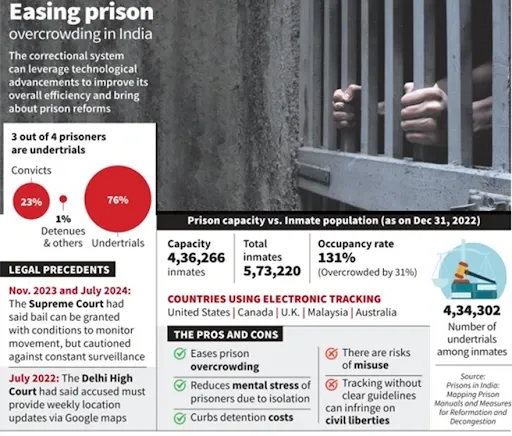Context:
The Union Home Minister recently highlighted the importance of releasing undertrial prisoners who have served more than one-third of the maximum sentence prescribed for their alleged crimes, aiming for this to be completed before Constitution Day on November 26. This directive is in line with the provisions introduced under the Bharatiya Nagarik Suraksha Sanhita, 2023 (BNSS), reflecting a move towards more equitable legal processes and reducing overcrowding in prisons.

Relevance:
GS II: Polity and Governance
Dimensions of the Article:
- Section 479 of the Bharatiya Nyaya Sanhita (BNSS)
- Supreme Court’s Role in Implementation
- Analysis of India’s Undertrial Population According to NCRB 2022
Section 479 of the Bharatiya Nyaya Sanhita (BNSS)
Revision of Bail Norms
- Purpose: Section 479 aims to address the issue of prolonged detention of undertrial prisoners, especially those who are first-time offenders.
- Context: This provision is an expansion of Section 436A of the Code of Criminal Procedure (CrPC), which previously allowed for release after serving half of the potential maximum sentence.
Bail Eligibility Criteria
- General Rule: Undertrials charged with non-capital offenses are eligible for bail if they have served half of the maximum sentence applicable to the offense.
- Special Consideration for First-Time Offenders: Those with no prior convictions are entitled to release on bond after serving one-third of the maximum prescribed sentence.
- Exclusions: This leniency does not apply to individuals charged with multiple offenses or those under investigation for other crimes.
Supreme Court’s Role in Implementation
Retrospective Application
- Effective Date: Section 479 is applied retrospectively to cases that were active before the BNSS’s enactment on July 1, 2024.
- Court’s Order: In August 2024, the Supreme Court mandated the retrospective application of this section.
Measures for Effective Implementation
- Role of Jail Superintendents: They are tasked with identifying eligible prisoners and coordinating with courts to facilitate their release.
- State Compliance: States and Union Territories are required to submit detailed affidavits within two months, reporting on the status of eligible undertrials.
Monitoring and Compliance
- Recent Compliance Rates: As of October 2024, only 19 out of 36 states and UTs have complied with the Supreme Court’s directives.
- Focus on Women Undertrials: In November 2024, the Supreme Court specifically called for prioritizing the identification and potential release of women undertrials.
Analysis of India’s Undertrial Population According to NCRB 2022
Overview of Undertrial Inmates
- High Proportion of Undertrials: The National Crime Records Bureau (NCRB) 2022 report shows a significant percentage of undertrials in the total prison population, with 4,34,302 out of 5,73,220 inmates (75.8%) awaiting trial.
- Female Undertrials: Of the total women incarcerated, 18,146 out of 23,772 are undertrials, making up 76.33% of the female prison population.
- Duration of Detention: Approximately 8.6% of these undertrials have been detained for over three years as of the end of 2022.
Lack of Specific Data
- Data on First-Time Offenders: The report does not specify the number of undertrials who are first-time offenders, a critical data point for the effective application of Section 479 of the BNSS.
-Source: The Hindu




